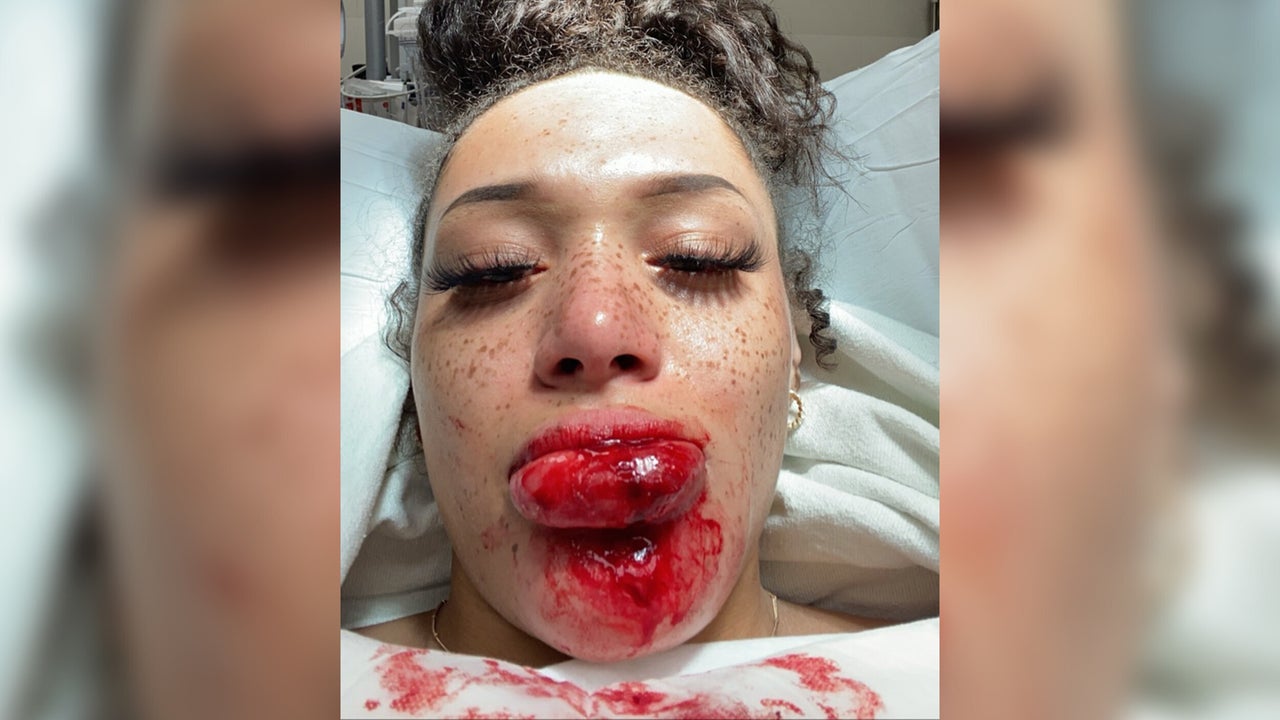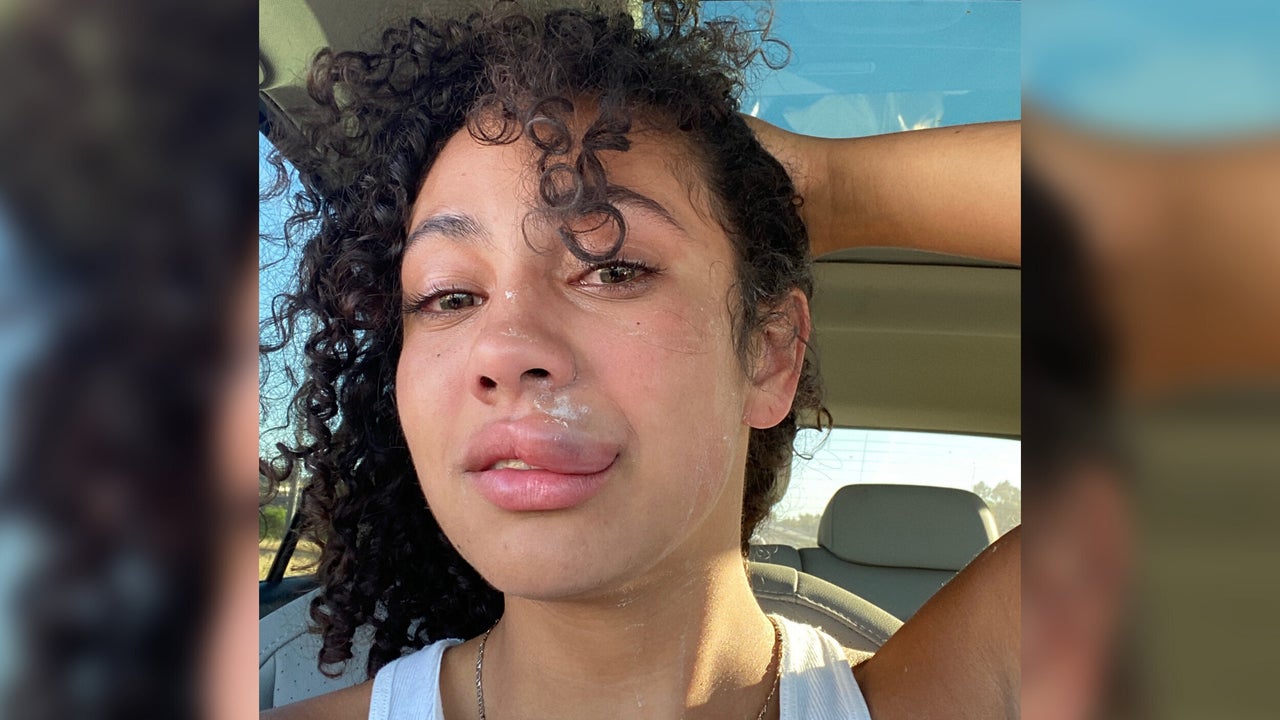Amara Green wasn’t entirely sure what hit her.
The 19-year-old had been at a protest in downtown Minneapolis at around 8 p.m. on May 27. She was in the middle of a crowd across the street from the Minneapolis Police Department’s 3rd Precinct headquarters. All Green remembers is her boyfriend trying to push her out of the way as a flying object hit her bottom lip.
“There was this ringing in my ears,” Green said. “I knew my lip was gushing blood, but I didn’t know what was going on.”
Fellow protesters helped Green and her boyfriend push through the crowd to an area where medical volunteers could appraise her injury. She was told to get to the emergency room, because she was going to need stitches. (Warning: graphic photo below.)
“My lip and chin had both been busted open,” Green said. “While they sewed me up, they told me that my jaw may have shifted, and I would maybe need reconstructive surgery.”

The care will likely cost her thousands of dollars. Though she had previously been covered under her mother’s health insurance, her mom had recently lost her job. It wasn’t until a few days later that she learned her injury was from a “less lethal” weapon police had fired into the crowd: rubber bullets.
Rubber bullets are formally known as “kinetic impact projectiles,” and are not always made of rubber. Some are wood, plastic or even have a metal core. Rubber bullets have been used for decades to subdue riots, and are now being aimed at protesters, journalists and uninvolved bystanders as protests continue throughout the country over the deaths of George Floyd, Breonna Taylor and other victims of police brutality. And while researchers have known for years that “less lethal” can still be deadly, police units in the United States continue using them.
“To even use the word ‘safe’ is a misnomer,” said Ian Wittman, chief of emergency medicine at NYU Langone Hospital. “It is absolutely, unequivocally unsafe to use these ammunitions.”
From Northern Ireland To The Civil Rights Movement
The use of kinetic impact projectiles can be traced as far back as the 1880s, when police in Singapore used the ends of wooden broom handles to subdue rioters protesting an array of social issues. By the 1970s, the British Ministry of Defence began using rubber bullets in Northern Ireland during the Troubles.
And with the civil rights movement underway in the U.S., President Lyndon B. Johnson created a blue ribbon commission in 1966 to explore less lethal ammunition for protests and riots. Manufacturers began producing less lethal weapons to sell to American police departments.
But in 2003, the BBC published declassified document from 1977 detailing legal advice for the Ministry of Defence to push for a settlement with the family of a young boy who had been blinded by a rubber bullet. The concern was that going to court would lead to further investigation that would expose how the bullets had not been tested properly and had caused more serious injuries in the past.
A National Center for Biotechnology Information study examining injuries from 1990 to 2017 found that over 71% of all injuries from rubber bullets and similar projectiles were severe, leading to at least 53 deaths and another 300 permanent disabilities during that period.
Zeelee Segura was attending a May 30 protest in La Mesa, California, when she was shot in the mouth, a high risk area, with a rubber bullet.
“I didn’t know you could actually see a bullet as it’s coming towards you,” Segura said. “I was just happy it hit me and not the pregnant woman next to me. There were some little kids not too far away from me either.”

In the first 24 hours after, Segura was in so much pain that she couldn’t touch her face. Nearly a week later, the 21-year-old is having nightmares from the incident. She often wakes up dry heaving from panic attacks. Although she’s seen a doctor, she is still worried about long-term damage to her teeth.
“If I close my eyes and try to remember what being hit felt like, it was like a real bullet,” Segura said. “In the moment, I couldn’t tell the difference.”
Mike Griffin, 34, a senior organizer at Community Change Action, says he’s seen countless injuries from batons, tear gas canisters and rubber bullets every day in Minneapolis since demonstrations began.
“I’ve seen welts the size of a baseball, and I’ve seen people rushed to the hospital for internal bleeding or because a bullet hit an eye,” Griffin said. “I don’t even get why any of these are called ‘less lethal.’”
Wittman said most physicians feel the same way.
“It’s a heavy object being shot out of a gun at a high rate of speed at a human body,” Wittman said. “The most common injuries are fractures or ruptured blood vessels and nerves. If it hits someone’s eyes, they have a high likelihood of losing vision, and there are sometimes skull and intracranial fractures.”
Dangerous And Untrained
There aren’t any national standards when it comes to training police officers to use less-lethal weapons, so it’s often up to the discretion of each police department. And using a rubber bullet is a speciality skill, because where it’s aimed can make a huge difference in the damage it does.
Steve Ijames, a Missouri police officer who has traveled the world training police departments on how to use less-lethal weapons, believes that less-lethal ammunition can save lives when used correctly, but acknowledges that the level of training each police department receives on how to use them can vary.
“The adequacy of training varies from state to state,” Ijames said. “My training can be as long as a full eight-hour day, but it could also be a 15-minute briefing in the range where someone said, ‘Here’s a beanbag [bullet], just shoot the arms and legs.’ I’ve seen that before.”
With protests occurring all across the country each day, police departments are running out of this ammunition, and turning to other departments for help.
“Most police agencies are poor planners, and historically very reactionary, so they have very little or no knowledge on less-lethal ammunition,” Ijames said. “Manufacturers right now are already overwhelmed by demand as is, so police departments are now trying to beg and borrow ammunition from other departments. It hasn’t been this bad since Ferguson.”
This scramble is why Dennis Kenney, a criminal justice professor at John Jay College in New York City and a former police officer, thinks most rubber bullets are shot by people who don’t know how to use them.
“Most agencies also don’t have that kind of equipment just laying around, and training can be cumbersome if you have to take people out of service,” Kenney said. “So when you see all of this equipment during protests, they haven’t had a lot of time for the advanced training. It’s very safe to assume that very few of them have been properly trained.”
Kenney also noted that shooting at a crowd means the target is constantly moving, which also decreases accuracy and increases the likelihood of severe injury.
“In general, nonlethal force is used to overcome resistance, not to maintain compliance,” Kenney said. “Rubber bullets are impact devices that tend to inflict pain, when the force used to overcome resistance is being met. But in a good deal of these cases, the resistance is low. It’s about getting a crowd to comply. Using a device of that significance seems to be excessive.”
The number of reported injuries continues to climb. On May 31, 20-year-old Justin Howell was shot in the skull with a rubber bullet, and is expected to have permanent brain damage. A GoFundMe campaign has already raised nearly $150,000 as of Saturday to help cover his medical bills. Meanwhile, a federal judge is now temporarily prohibiting Denver police from using less-lethal weapons, including projectiles like rubber bullets, at protests.
Green has also started a GoFundMe to help cover her upcoming surgeries. In a few days, she was able to raise over $14,000.
“I was so overwhelmed, I broke down in tears,” Green said. “I mean, I don’t even know these people.”
And while Green may be looking at months of rehabilitation, she thinks it was worth it.
“Even if this money hadn’t happened, I still wouldn’t regret going to the protest at all,” Green said. “It was really scary, but it made me stronger.”
